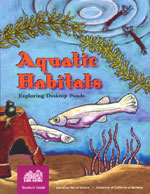Aquatic Habitats
Exploring Desktop Ponds
Grades 2—6
Written by Katharine Barrett and Carolyn
Willard
Creating and expanding their own little aquatic worlds over a
period of weeks, student groups learn to observe, record, predict,
and draw inferences; these are the mainstreams in Aquatic Habitats.
In this compelling and unique series of life-science activities
for a variety of age groups, desktop model ponds develop and change
over time, allowing students to discover firsthand some of the
complex interactions within a typical pond ecosystem.
Unlike clean, filtered aquariums, these aquatic habitats more
closely model what happens in the natural world. Plants, worms,
snails, fish, and other organisms compete for limited space, food,
and resources. Concepts such as life cycles and food webs take
on real and memorable meaning as students become increasingly
drawn into the drama of life itself.
The GEMS guide Terrarium Habitats
makes a wonderful companion to this unit, exploring parallel activity
in a terrestrial ecosystem.
Praise for Aquatic Habitats:
"In addition to the basic activities, recommendations for
extensions and a field trip to a pond are included. There is sufficient
material here for teachers to involve children in four to six
weeks of an ongoing inquiry. The book includes comprehensive,
clearly stated directions, a list of all required materials, a
list of suppliers, and suggestions for substitute materials. The
writers also provide teachers with background information, questions
to guide the childrenís inquiries, and an annotated list of related
curriculum materials and books for children to read. This is an
excellent instructional resource, and I recommend it highly."
—Science Books and Films
Comment on this GEMS unit.
|

Order
online
Ordering information
Literature Connections
What materials are needed to present this unit? See the full list. |

